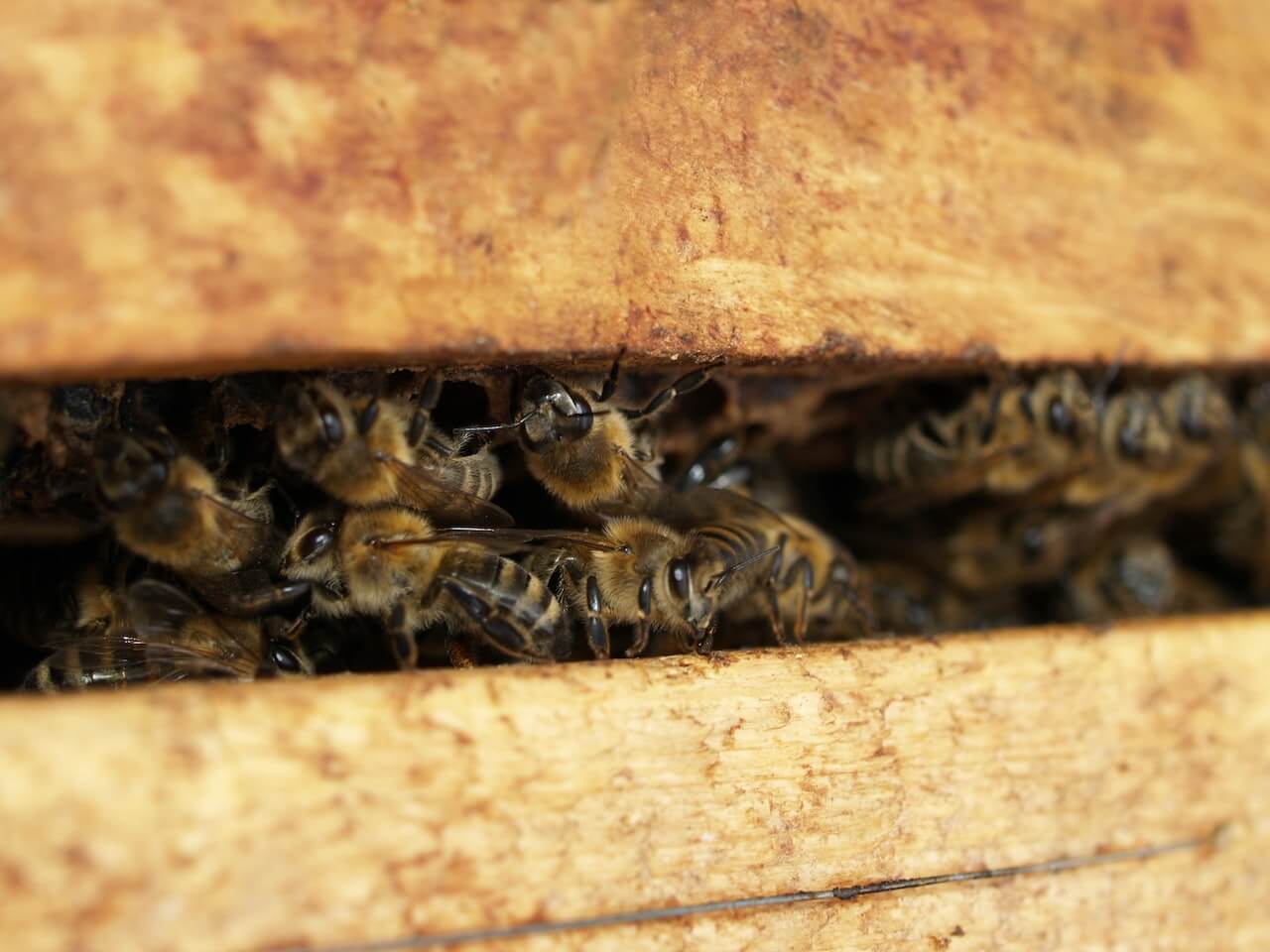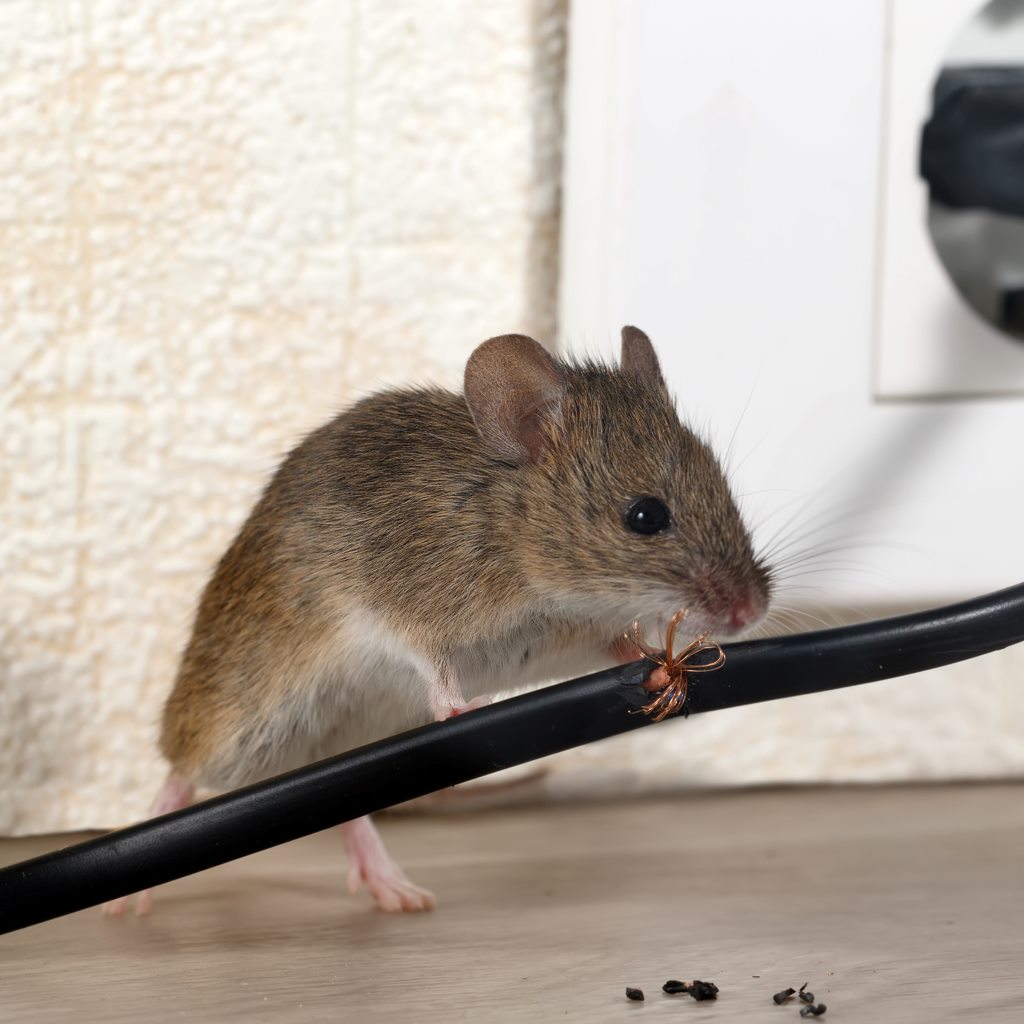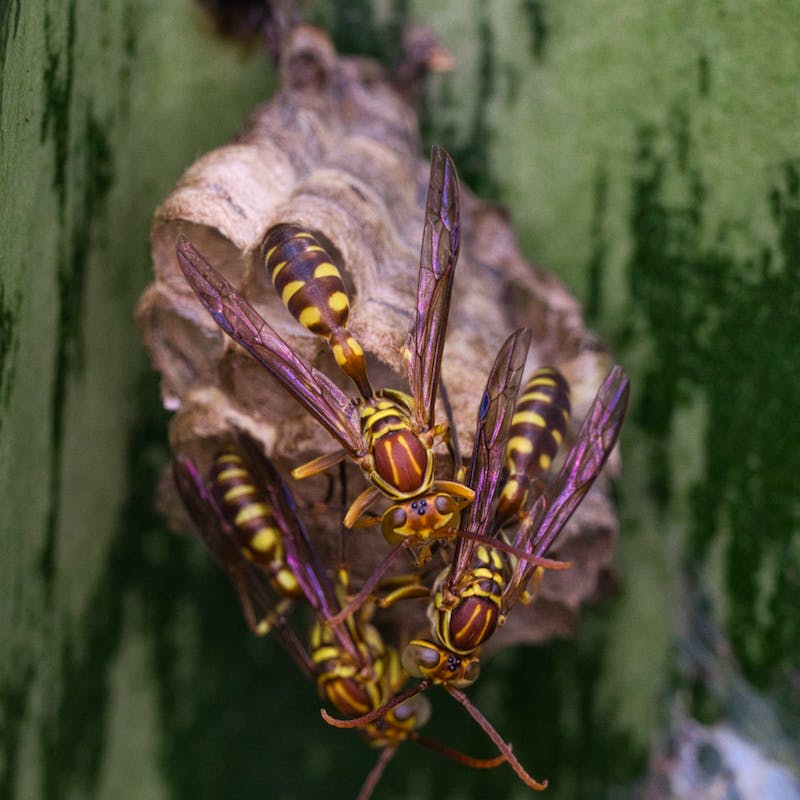
22 Jun 2023 | Trifecta Pest Solutions (UK) Ltd
We’ve all seen the humble bee flying around in our garden and for the most part this is no cause for concern. However, the presence of a bee can point towards there being a nest on your property - either in your house or garden.
If this is the case, you need to know how to get rid of bees ethically and this is what we discuss below. The simplest answer is to call a professional to assess the situation and remove the bees safely.
To give you more insight though, we look at the different methods used, and help you understand more about the types of bees, their nesting habits, and the potential dangers they pose.
Most Popular Bee Types in the UK
Understanding the problem is the first part of solving it. This holds true for how to make bees go away and by knowing the different types of bees in the UK you can better tackle the problem of removing them.
Bumblebees
The bumblebee is widespread throughout the UK and they have much smaller colonies compared to honey bees ranging from as little as 50 insects up to 400. Within the colony, there are queens, male drones, and workers.
The nests are again smaller than honey bee colonies and depending on the bumblebee species, they like to nest underground in things like rodent burrows, or above ground in grass thickets or tree holes.
Bumblebee nests may be found in homes but they don’t last as long and rarely cause structural damage. You are more likely to find bumblebee nests in your garden. Only the queen and worker bees have a sting and they will rarely do so unless they are threatened.
Common Carder Bees
The common carder bee is a type of bumblebee that generally nests in old birds' nests, outbuildings like sheds, and old mouse nests. You may rarely find them nesting in homes but they prefer to construct nests in the aforementioned locations or underground.
Carder bee colonies are much smaller and you typically have a queen and maybe 100-200 adult workers who collect pollen. Their preferred food source is wildflowers like nettles, knapweed, white clover, and monkshood.
These bees can be defensive and protective of the flowers they are pollinating but will rarely sting.
Mason Bees
Mason bees are named so because they typically construct their nest from materials like mud and other natural debris. They are solitary bees and do not form colonies, nor are there any worker bees. You simply have fertile females and males who are used for mating.
You may find mason bees nesting in holes in your mortar or woodwork inside cavity walls. They can cause structural damage as they burrow into the materials but they will not cause any staining or build-up of pressure inside walls because they don’t produce honeycomb structures.
Mason bees are generally quite docile and there is much less chance of being stung.
Honey Bees
Honey bees are what most people think of after the bumblebee and these have the potential to cause the most property damage. Honey bees operate in immense colonies which can include 100,000+ insects.
They create large honeycomb structures inside walls and brickwork and these can put strain on the structural integrity of your property. The honey and wax can also seep through walls and cause staining and weakening.
Within a honey bee colony, you have the queen, workers, and drones and they all play an important role in the continued survival of the colony. Worker bees will defend the colony and sting intruders.
The sting is barbed and venom is released however it is generally not toxic to humans but can cause pain and swelling. However, some people can have severe allergic reactions and will need emergency treatment.
Reasons to Get Rid of Bee Nests and Hives
So, you now know the different types of bees and you may be wondering what the big fuss is. Why do you even need to get rid of bees from your property? Aside from the obvious potential to get stung, I have detailed the other important reasons below.
Noise
A bee nest can be incredibly noisy depending on the size and number of bees. Even smaller colonies like those of common carder bees can cause a racket!
Imagine the potential noise if you are unlucky enough to have a huge honey bee colony in your walls. With the possibility of hundreds of thousands of bees buzzing around, it can cause some serious noise pollution.
Allergies
If you suffer from allergies such as hay fever during the spring and summer then bees can potentially aggravate this. All the bee types we mentioned above pollinate and thus are carrying pollen back and forth from flowers to nests.
This increased presence of pollen can be incredibly irritating and set off your allergies in an instant! The extreme of this is if you get stung too and have an allergic reaction which can be potentially fatal.
Structural Damage
Honey bees and mason bees can also cause physical damage to your property. If a honey bee nest is established in your walls or inside your brickwork then it can have numerous effects.
Firstly, the strain from the large honeycomb structures can put stress on your interior petition walls and cause cracking and structural damage. Secondly, the honey and wax can seep through your walls - just do a quick Google image search for “honey bee wall seeping” and you will see the problems this can cause!
Mason bees can also cause havoc if they decide to create a nest in structural woodwork in your home such as petition wall frames or attic eaves. The mason bees physically burrow into the wood and create holes that can compromise the integrity of the wooden beam for example.
Stinging
Last but not least, whenever a bee is near, there is the potential to get stung! Generally, bees will only sting if they are threatened and if you act calmly and follow my instructions above you can minimize this chance.
But still, it can happen, and it hurts! Speaking from experience it’s not a pleasant sensation. A bee sting will generally leave you feeling a little sore and can cause swelling, but there is the potential for a severe allergic reaction known as anaphylaxis. If this is severe, it can require immediate emergency medical treatment and in rare cases, be fatal.
How to Naturally Get Rid of Bees
As you can see, despite their vibrant appearance, these insects can cause some serious problems so you need to know how to naturally get rid of bees. I have listed 6 common methods below that professionals can perform:
Use a Spray
A simple preventative measure is to use bee-repellant spray. You can find a range of sprays that cause no harm to the bees and are effective at keeping them away from your house. This may not be successful for bee nest & hive removal though if the colony is established.
Many natural ingredients are used in sprays including eucalyptus, lemongrass, peppermint, and citronella. The strong aromas interfere with their sense of smell and cause them to deem the area unsafe to colonize.
Use Insecticide
There are unfortunately some instances where ethical bee removal isn’t possible in which case insecticide could be a viable solution. Insecticides are primarily used to kill unwanted insects so they will kill bees and wasps.
Bees can die on direct impact of insecticides but they can also carry insecticide back to the colony and infect the queen and brood and effectively wipe out the entire colony. This is a method that ethical pest controllers will always avoid where possible and the first option is to remove the bees naturally so that the colony can be relocated and survive.
Make a Bee Trap
Bee traps are another unethical method used as they kill the bees. Many people do try and make homemade bee traps and the process is simple, but it’s something I do not advocate.
A bee trap can be made from a plastic drinks bottle cut in half. The spout is turned upside down, pointing towards the bass, and stapled to the inside of the other half. You then pour honey into the bottom of the bottle or sugar and water and hang it up.
The honey or sweet sugar attracts the bees and they enter through the small opening, get stuck in the honey, cannot fly out, and eventually die.
Use Vinegar
It always amazes me how many uses vinegar has and while it’s perfect on a plate of chips, it’s a great bee repellant too. With a spray bottle, create a solution of vinegar and water in equal parts and spray it around the nest.
Bees hate vinegar and they will get annoyed and relocate. This is a great method as it doesn’t kill the bees either providing that you use a diluted solution mixed with water. If you spray pure vinegar then the high acidity will kill the bees.
Bee Repellant Plants
Although bees love flowers and plants there are many plants that they simply loathe and strategic use of them can help repel these insects from your property. Examples of bee-repellant plants include:
- Lavender
- Basil
- Mint
- Rosemary
- Citronella
- Lemongrass
- Marigolds
- Pennyroyal
Placement of plants like these in your garden can help control bees and keep them away. You may still get the odd worker bee collecting pollen, but you are less likely to get bee nests where there are plenty of these plants.
Use Mothballs
Mothballs are a type of pesticide that is used to kill moths and other insects to protect your clothing but they can also be used to get rid of bees.
Both bees and wasps dislike the smell of mothballs so you can consider hanging mothballs in a bag near the nest and it should deter them.
Please note that using mothballs in an enclosed area will most likely kill the bees. This is because toxic gas is released and when this is confined in a small area the bees will breath it in and die. When used outside, the gas is dispersed more widely and thus has a much lower chance of being fatal, but instead a deterrent.
How to Stay Safe When You Have a Bee Nest in Your Garden?
When looking at how to get rid of bees we can’t overlook that in-between period - the time when you have noticed a nest until it is removed.
During this period it’s still perfectly safe to go out and about in your garden as usual - you just need to take a little extra care. Bees and humans can co-exist peacefully together and to improve your safety you can do the following:
- Be aware of your surroundings.
- Always stay calm.
- Dress appropriately where possible.
- Keep children and pets away from the nest.
- Know what to do if stung
I always make a mental note of where a nest is and make sure that everyone else on the property is aware too. Staying aware of your surroundings means you are less likely to disturb the bees and aggravate them.
You can reduce the chance of bee stings by dressing appropriately too such as covering your arms and legs. I get that it’s not always possible to do this as you don’t want to be gardening in your jeans and jumper in the summer!
If you have children, make sure you educate them about bees and the potential dangers and show them where the nest is so they do not play near it. Although you can’t educate pets, you must be vigilant and keep them from the common areas where you notice the bees.
Failing all this, if a bee does take an interest in you, STAY CALM! The worst thing you can do is start flailing and trying to bat it away - the poor little critter will get agitated, and defensive, and is far more likely to sting. Keeping calm, just move slowly and show the bee you are not a threat.
I also advise learning a little bee sting first aid so if the worst-case scenario happens, you know how to remove a sting and look for signs of allergic reactions in humans or pets.
When to Call a Professional?
You should now have a clearer understanding of how to make bees go away and I hope you have confidence that there is always a solution. You may now be tempted to tackle the problem yourself and I get this - it feels incredibly rewarding to do something like this on your own.
However, the underlying fact is, is that it’s much safer, and better for everyone involved if you call a professional for assistance. You may start tackling the bees nest in good faith and it may seem like a small job. The reality is that what looks like a doddle, however, could soon turn into a dangerous venture and put both you and the bees in harm's way.
If you suspect you have a bees nest on your property - even if it is just in your garden, it’s advisable to call a professional immediately. They can assess the situation, suggest the best course of action, and remove the nest ethically so the bee colony can survive.
Conclusion
I hope you have enjoyed this insight into the world of bees and have renewed confidence if you happen to discover a nest on your property. In such an event, the first option is to seek professional help.
Professional pest removal firms know how to naturally get rid of bees to ensure the survival of their colony while also keeping you safe and causing no property damage. This is the preferable solution as it is completely ethical, and after all, while bees can be annoying, they are a vital part of our natural ecosystem!
Frequently Asked Questions
Can I remove a bees nest myself?
It is possible but I don’t recommend it. There are so many considerations when looking at how to get rid of bees nest it can get really complicated. You may also put yourself in danger if the colony gets agitated and becomes aggressive. It is better to call a professional and have the removal done safely and ethically.
Should I destroy a bees nest?
A nest should only ever be physically destroyed if the bee colony has been completely relocated. If the bee removal is successful and all that’s left is an old nest then it can be removed and disposed of. Never try and destroy an active bees nest as you can enrage the colony and cause them and yourself harm.
How do you get a bees nest down?
There is a range of ethical methods to remove a bees nest including vinegar, bee-repellant plants, mothballs, repellant spray, bee traps, and bee cut-outs. Simple spray methods are quick and effective but it is still advisable to seek the advice and assistance of a professional for larger nests.


